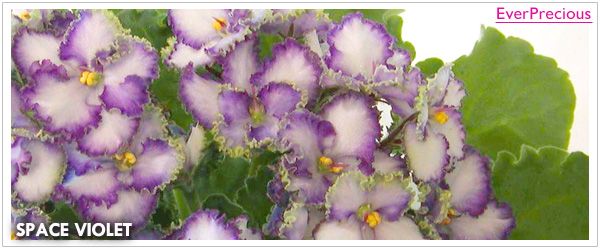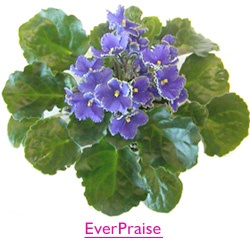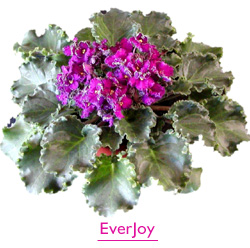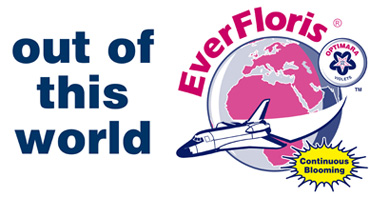| |
EverFloris Varieties are a direct outcome of the Optimara Space Violet program. The US Space Shuttle Program was retired in 2011, but the legacy lives on in EverFloris Space Violets! The development
of EverFloris Violets began in 1984, when 25,000 Optimara
seeds were launched into space aboard one of NASA's space shuttles. The seeds remained
orbiting the Earth for nearly six years aboard the Long Duration Exposure
Facility (LDEF).
 The Violet seeds were intended to go on a 1 year tour of outer space,
this became a 6 year odyssey. The Violet seeds were intended to go on a 1 year tour of outer space,
this became a 6 year odyssey.
The program was
conceived to test the effect of long-term exposure to cosmic radiation and
lack of gravity for 11 months.
Schedules ran late and pushed the satellite retrieval back to 1986. After more delays the LDEF was recovered in January 1990 by Space Shuttle Columbia on mission STS-32.
When the seeds were retrieved & germinated,
many mutations soon
became apparent. One such mutation resulted in a new characteristic which
Optimara has dubbed 'multiflorescence.' This characteristic gives Optimara
Violets an extraordinary abundance of flowers which never stop blooming.
Compared with PMA standards, which define a finished African Violet as having
five to seven open blooms, a multiflorescent Optimara variety will have
at least 20 open blooms. For a listing and a variety detail of EverFloris violets, click
here.
 Multiflorescence is just one of the remarkable characteristics that make
EverFloris Violets so unique.
In addition to larger, fuller blooms that
flower continuously, EverFloris varieties have been developed to grow bigger.
Overall, they are as much as 50 percent bigger. To accommodate their larger
growing size, EverFloris Violets are cultivated in a 6-inch pot (instead
of the standard 4-inch pot). Multiflorescence is just one of the remarkable characteristics that make
EverFloris Violets so unique.
In addition to larger, fuller blooms that
flower continuously, EverFloris varieties have been developed to grow bigger.
Overall, they are as much as 50 percent bigger. To accommodate their larger
growing size, EverFloris Violets are cultivated in a 6-inch pot (instead
of the standard 4-inch pot).
EVERFLORIS CARE
Like all Optimara Violets, EverFloris varieties are easy to grow.
Below
is a summary of what you need to know to successfully grow and care for
EverFloris Violets.
For more detailed care instructions, see Caring
for African Violets.
Water: Keep soil evenly moist, but never soggy. Use room-temperature
water,
and avoid splashing water on the leaves.
 OverWatering: To minimize the dangers
of overwatering or underwatering, OverWatering: To minimize the dangers
of overwatering or underwatering,
use a self-watering device, such as the
Optimara Watermaid.
The
Optimara Watermaid will provide your EverFloris Violets with the right amount
of water for up to two weeks.
Fertilizer: Use Optimara
Violet Food 14-12-14, each time you water.
Optimara Violet Food provides
the proper balance of nutrients for optimal flowering and vigorous growth.
Light: EverFloris Violets, like all African Violets, perform best
when they receive plenty of indirect sunlight.
This can be achieved with
sheer curtains or partially closed blinds.
Climate: Keep temperature at 60 to 80 degrees F. Ideal temperature
is about 70 degrees.
Humidity should be at least 40 to 60 percent.

"Like" Us on FaceBook
for the Latest Space Violet Photos &
& Exclusive Photos of New Varieties in Development!

Copyright 1999-2002 Optimara/Holtkamp Greenhouses, Inc.
Nashville, Tennessee. Doctor Optimara, the Doctor Optimara logo and Optimara
Field Guide are trademarks of Holtkamp Greenhouses, Inc. Optimara, the Optimara
logo, EverFloris, MiniWell, MaxiWell, WaterShip and Watermaid are trademarks
of International Plant Breeding, A.G., Switzerland.
|



